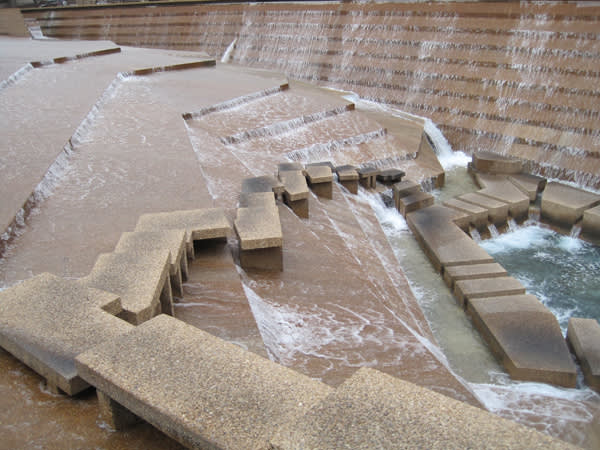
Philip Johnson
Water Gardens, Fort Worth, Texas, 1974
Nothing screams summertime like flower-filled gardens and fresh water. So, what happens when you combine the two? Leave it to modernist architect Philip Johnson to offer an innovative answer to one of life’s most beautiful, unexplored design questions, with the opening of the Fort Worth Water Gardens in 1974.
Nearly a decade after completing the International-style Amon Carter Museum in the Texas city, Johnson was invited back to Fort Worth by his previous patron, Ruth Carter Johnson, for a wide-open urban design project free of restrictions. Built in an effort to create an urban oasis and reclaim an area of the city that had fallen into despair, the four-acre park opened in Fort Worth in 1974 as a gift from the Carter Foundation to the town’s residents.

Portrait of Philip Johnson
An architectural and engineering marvel packaged in a modernist landscape of vortex-like pools and futuristic angels, Johnson designed the outdoor oasis around three primary bodies of water as well as a terraced knoll and a commanding concrete mountain.

Philip Johnson
Water Gardens, Fort Worth, Texas, 1974
The site’s quiet mediation pool is surrounded by trees and water cascading down the area’s walls, while the nearby aeration pool is equipped with 40 nozzles spraying 781 gallons of water every minute; from which the mist creates an illusion of a water bridge connecting one side of the walkway to the other.

Philip Johnson
Water Gardens, Fort Worth, Texas, 1974

Philip Johnson
Water Gardens, Fort Worth, Texas, 1974
Last but not least, the centerpiece of the Fort Worth Water Gardens is the Active Pool where thousands of gallons of water cascade down a 38-foot series of geometric steps and platforms into an aqua-filled vortex. Johnson’s design invites the public to descend the site’s eleven-meter, terraced crater to a small central pool offering visitors a one-of-a-kind water experience.

Philip Johnson
Water Gardens, Fort Worth, Texas, 1974

Philip Johnson
Water Gardens, Fort Worth, Texas, 1974

Philip Johnson
Water Gardens, Fort Worth, Texas, 1974

Philip Johnson
Water Gardens, Fort Worth, Texas, 1974
Like a number of Johnson’s most celebrated projects, the Fort Worth Water Gardens embody the remarkable beauty achieved when a leading architect and trustworthy patron come together for the purpose of bettering a city through design.

Philip Johnson
Water Gardens, Fort Worth, Texas, 1974



